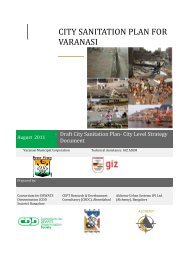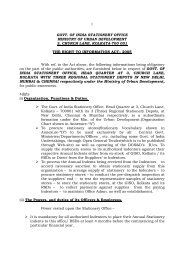CITY SANITATION PLAN - Ministry of Urban Development
CITY SANITATION PLAN - Ministry of Urban Development
CITY SANITATION PLAN - Ministry of Urban Development
Create successful ePaper yourself
Turn your PDF publications into a flip-book with our unique Google optimized e-Paper software.
<strong>CITY</strong> <strong>SANITATION</strong> <strong>PLAN</strong> BAREILLY<br />
The Double VIP has almost the same design as the Single VIP with the added advantage <strong>of</strong> a second<br />
pit that allows the technology to be used continuously and allows for safer and easier emptying. By<br />
using two pits, one pit can be used while the contents <strong>of</strong> the second pit rests, drains, reduces in<br />
volume, and degrades. When the second pit is almost full (the excreta is 50cm from the top <strong>of</strong> the<br />
pit), it is covered, and the contents <strong>of</strong> the first pit are removed. Due to the extended resting time (at<br />
least 1 year <strong>of</strong> filling/resting) the material within the pit should be sanitized and humus-like. The<br />
Double VIP is specifically designed to produce humus and as such, it requires regular additions <strong>of</strong><br />
soil, ash and/or leaves.<br />
The superstructure may either extend over both holes or it may be designed to move from one pit to<br />
the other. In either case, the pit that is not being filled should be fully covered and sealed to prevent<br />
water, garbage and animals (and/or people) from falling into the pit. The ventilation <strong>of</strong> the two pits<br />
can be accomplished using one ventilation pipe moved back and forth between the pits or each pit<br />
can be equipped with its own dedicated pipe. The two pits in the Double VIP are continually used<br />
and should be well lined and supported to ensure longevity.<br />
Adequacy: The Double VIP is more appropriate than the Single VIP for denser, peri-urban areas. The<br />
material is manually emptied, so vacuum truck access to the pits is not necessary. The users can<br />
remove the pit material after a sufficient resting time <strong>of</strong> one or more years even though the<br />
treatment processes in the pit are not complete and the material is not entirely hygienic. The Double<br />
VIP technology will only work properly if the two pits are used sequentially and not concurrently.<br />
Therefore, an adequate cover for the out <strong>of</strong> service pit is required. Double VIPs are especially<br />
appropriate when water is scarce and where there is a low groundwater table. They should be<br />
located in an area with a good breeze. They are not suited for rocky or compacted soils (that are<br />
difficult to dig) or for areas that flood frequently.<br />
Health Aspects/Acceptance: The Double VIP can be a very clean, comfortable and well accepted<br />
sanitation option. However some health concerns exist:<br />
• Latrine leachate can contaminate groundwater;<br />
• Pits are susceptible to failure/overflowing during floods; and<br />
• Health risks from flies are not completely removed by ventilation.<br />
Maintenance: To keep the Double VIP free <strong>of</strong> flies and odours, regular cleaning and maintenance is<br />
required. Dead flies, spider webs, dust and other debris should be removed from the ventilation<br />
ADMINISTRATIVE STAFF COLLEGE OF INDIA, HYDERABAD Page 153
















